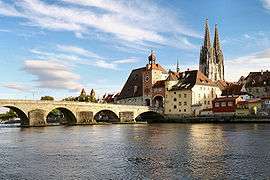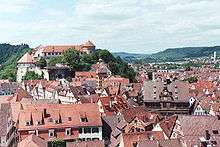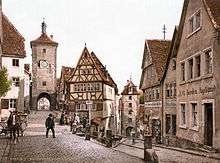Altstadt



Altstadt is the German language word for "old town", meaning "historical city centre within the city wall", in contrast to younger suburbs outside. Neustadt (new town), the logical opposite of "Altstadt", mostly stands for a part of the "Altstadt" in modern sense, sometimes only a few years younger than the oldest part, sometimes a late medieval enlargement.
Most German towns have an Altstadt, even though the ravages of war have destroyed many of them, especially during the Thirty Years' War (1618-1648). In the "War of the Palatinian Succession" of 1688, the order to Brûlez le Palatinat! was executed by Mélac, devastating many cities and large parts of South Western Germany, like the Heidelberg castle.
Allied Strategic bombing during World War II destroyed nearly all large cities, with Dresden being the most prominent victim. Many smaller towns remained intact, for example Tübingen, Dinkelsbühl, Quedlinburg and Wismar. Some Altstadt parts in Freiburg, Berlin, Münster, Rothenburg ob der Tauber and famously Weimar and others have been restored. But most destroyed bigger German old towns were not reconstructed. Important old towns like those of Hildesheim, Braunschweig, Frankfurt, Kassel and Pforzheim were largely lost or only reconstructed in limited areas.
Recent efforts of Altstadt reconstructions can be found in Dresden (Neumarkt area), Potsdam (the old market and city palace) and Frankfurt (Römerberg around the Cathedral).
Examples of Altstadt districts in cities and towns
Austria
Germany
- Aachen
- Amberg
- Baden-Baden
- Bamberg (a World Heritage Site)
- Bayreuth
- Bernkastel-Kues
- Bietigheim
- Büdingen
- Celle
- Cologne (Altstadt Nord & Süd)
- Dinkelsbühl
- Düsseldorf (Altstadt (Düsseldorf))
- Erfurt
- Freiburg (de:Altstadt (Freiburg im Breisgau))
- Gernsbach
- Görlitz (de:Görlitzer Altstadt)
- Goslar (a World Heritage Site)
- Güstrow
- Hamburg (Altstadt)
- Heidelberg (de:Heidelberger Altstadt)
- Konstanz
- Landshut
- Limburg an der Lahn
- Lindau
- Lübeck (a World Heritage Site)
- Lüneburg
- Marbach am Neckar
- Marburg
- Mosbach
- Munich (Altstadt-Lehel)
- Neustrelitz
- Nuremberg
- Nördlingen
- Putbus
- Quedlinburg (a World Heritage Site)
- Ravensburg
- Regensburg (a World Heritage Site)
- Rostock
- Rothenburg ob der Tauber
- Rüdesheim
- Schwerin
- Stade
- Stralsund (a World Heritage Site)
- Tangermünde
- Trier
- Tübingen
- Überlingen
- Waren (Müritz)
- Weingarten (Baden)
- Weinheim
- Wernigerode
- Wetzlar (de:Historische Altstadt Wetzlar)
- Wismar (a World Heritage Site)
Switzerland
- Baden (AG)
- Bellinzona
- Bern (UNESCO)
- Biel/Bienne
- Bremgarten (AG)
- Brugg
- Bulle
- Delémont
- Eglisau (ZH)
- Fribourg
- Greifensee (ZH)
- Gruyères
- Kyburg (ZH)
- Lausanne
- Lavaux
- Luzern
- Müstair
- Rapperswil (SG)
- Regensberg (ZH)
- Romont
- Murten
- Rheinau
- Schaffhausen
- Solothurn
- St. Gallen
- Stein am Rhein
- Vevey
- Wil (SG)
- Winterthur
- Zürich
Other towns
Notable Altstadt districts in cities that used to be inhabited also by a German-speaking population
Notable Altstadt districts in cities and towns that were destroyed
Staryi Sambir - "Old Sambir" was also known as Altstadt, equivalent to the Polish Staremiasto.
Gallery
-
Castles of Bellinzona
-
Greifensee and its castle, as seen from the Gallus chapel
-
Lausanne and its cathedral
-
Rapperswil Castle and Altstadt of Rapperswil (SG) located at Lake Zürich
-
Altstadt of Schaffhausen, as seen from Munot
-
Altstadt (parts of: Schipfe) and Lindenhof hill in Zürich
Coordinates: 47°29′56″N 8°43′43″E / 47.49889°N 8.72861°E